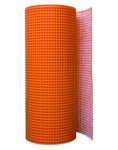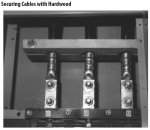You are using an out of date browser. It may not display this or other websites correctly.
You should upgrade or use an alternative browser.
You should upgrade or use an alternative browser.
Panel with cardboard or wood to protect wire from edges in panel
- Thread starter MPdesign
- Start date
- Status
- Not open for further replies.
- Location
- Chapel Hill, NC
- Occupation
- Retired Electrical Contractor
Not sure there is a rule against having wood in a panel. Personally, I don't like it but I can't find an article that would disallow it.
KnightPower
Member
- Location
- US
Splitting a piece of carlon works great.
Sent from my SM-N900P using Tapatalk
Sent from my SM-N900P using Tapatalk
- Location
- New Jersey
- Occupation
- Journeyman Electrician (retired)
This is as close as you may get if the circuit breaker is considered a device that produces arcs.
110.18 Arcing Parts. Parts of electrical equipment that in ordinary operation produce arcs, sparks, flames, or molten
metal shall be enclosed or separated and isolated from all
combustible material.
kwired
Electron manager
- Location
- NE Nebraska
- Occupation
- EC
Was this something used to protect conductors from abrasion when pulling and was left in place afterwards?
RumRunner
Senior Member
- Location
- SCV Ca, USA
- Occupation
- Retired EE
I have a few commercial panels with cardboard and wood left in the panels where there are bars or edges to protect the cable.
What is the code section that disallows this - and what should be done instead?
Thank you! :happyyes:
There are products made especially for this. Some are made of porcelain to support cables in man hole.
Since your application is inside panels, there is an outfit whose address escapes me that manufacture cable cleats made of silicone polymer. If you don't require custom shaped cleats you can use those with fluted side to provide a nest for the cables.
Google cable insulating cleats.
Good luck
JFletcher
Senior Member
- Location
- Williamsburg, VA
I have a few commercial panels with cardboard and wood left in the panels where there are bars or edges to protect the cable.
What is the code section that disallows this - and what should be done instead?
Thank you! :happyyes:
I've seen one hotel recently with 40 yr old FPE panels with wooden stakes bolted to the outside to act as wire gutters for tons of NM... ugliest thing I think Ive ever seen... funny thing is the feeders to the same panels are in RMC and a pretty huge wire gutter (10x10", maybe larger).
eta: not a NM staple anywhere to be seen....not sure when that was code but Ive seen older installs stapled within 2' of the panel... yes, I have pictures. :roll:
- Location
- Illinois
- Occupation
- retired electrician
So insulated wire is prohibited in electrical equipment, since the insulation is combustibleThis is as close as you may get if the circuit breaker is considered a device that produces arcs.
- Location
- San Francisco Bay Area, CA, USA
- Occupation
- Electrical Engineer
There is no Code restriction on wood, in fact wood mounting panels is often something used in certain applications (albeit I've never seen it in CB panelboards). Wood is also used in large incoming terminal compartments to lace and brace the cables. Cardboard in any capacity however is something I have seen rejected by AHJs on several occasions, even as a temporary work cover during construction. Besides, it's a terrible solution for permanent abrasion protection because it will break down fairly fast.
petersonra
Senior Member
- Location
- Northern illinois
- Occupation
- Semi-retired engineer
So insulated wire is prohibited in electrical equipment, since the insulation is combustible
Is insulated wire actually combustible? There is a difference between combustible and will burn under certain conditions.
jumper
Senior Member
- Location
- 3 Hr 2 Min from Winged Horses
So insulated wire is prohibited in electrical equipment, since the insulation is combustible
Well that make sense, but melting copper or aluminum could be hazardous also, so it is prolly best to not install any conductors in electrical equipment just to be on the safe side.
- Location
- San Francisco Bay Area, CA, USA
- Occupation
- Electrical Engineer
Well that make sense, but melting copper or aluminum could be hazardous also, so it is prolly best to not install any conductors in electrical equipment just to be on the safe side.
Which dovetails nicely with another common question; "If I punch a conduit hole in my enclosure, don't I violate the UL listing?"
No conductors, no conduit needed, so no holes, everything is good!
- Location
- Illinois
- Occupation
- retired electrician
By some definitions the insulation is not combustible as they require the product be easily ignitable.Is insulated wire actually combustible? There is a difference between combustible and will burn under certain conditions.
The International Fire Code says this "Combustible materials are natural or synthetic materials that can be ignited and support combustion." By that definition the insulation is combustible. This definition leaves out the "easily" part.
petersonra
Senior Member
- Location
- Northern illinois
- Occupation
- Semi-retired engineer
Here are some useful  definitions from the NFPA glossary of terms.
definitions from the NFPA glossary of terms.
Combustible Capable of reacting with oxygen and burning if ignited. [listed more then once]
Combustible A combustible material is any material that, in the form in
which it is used and under the conditions anticipated, will
ignite and burn or will add appreciable heat to an ambient
fire.
Combustible Capable of undergoing combustion. [This one is listed > ten times]
Combustible Capable of burning, generally in air under normal conditions
of ambient temperature and pressure, unless otherwise
specified. Combustion can occur in cases where an oxidizer
other than oxygen in air is present (e.g., chlorine, fluorine, or
chemicals containing oxygen in their structure).
Combustible A substance that will burn.
Combustible Capable of burning, generally in air under normal conditions
of ambient temperature and pressure, unless otherwise
specified; combustion can occur in cases where an oxidizer
other than the oxygen in air is present (e.g., chlorine,
fluorine, or chemicals containing oxygen in their structure).
Combustible A material or structure that will release heat energy on
burning.
Combustible (Material) A material that, in the form in which it is used and under the
conditions anticipated, will ignite and burn; a material that
does not meet the definition of noncombustible or limited combustible. [listed six times - actually maybe the most useful of the bunch]
Combustion A chemical process of oxidation that occurs at a rate fast
enough to produce heat and usually light in the form of
either a glow or flame. [they seem to have gotten this one right at least]
Combustible Capable of reacting with oxygen and burning if ignited. [listed more then once]
Combustible A combustible material is any material that, in the form in
which it is used and under the conditions anticipated, will
ignite and burn or will add appreciable heat to an ambient
fire.
Combustible Capable of undergoing combustion. [This one is listed > ten times]
Combustible Capable of burning, generally in air under normal conditions
of ambient temperature and pressure, unless otherwise
specified. Combustion can occur in cases where an oxidizer
other than oxygen in air is present (e.g., chlorine, fluorine, or
chemicals containing oxygen in their structure).
Combustible A substance that will burn.
Combustible Capable of burning, generally in air under normal conditions
of ambient temperature and pressure, unless otherwise
specified; combustion can occur in cases where an oxidizer
other than the oxygen in air is present (e.g., chlorine,
fluorine, or chemicals containing oxygen in their structure).
Combustible A material or structure that will release heat energy on
burning.
Combustible (Material) A material that, in the form in which it is used and under the
conditions anticipated, will ignite and burn; a material that
does not meet the definition of noncombustible or limited combustible. [listed six times - actually maybe the most useful of the bunch]
Combustion A chemical process of oxidation that occurs at a rate fast
enough to produce heat and usually light in the form of
either a glow or flame. [they seem to have gotten this one right at least]
I've seen a few older installs where cable clamps were made from treated plywood.There is no Code restriction on wood, in fact wood mounting panels is often something used in certain applications (albeit I've never seen it in CB panelboards). Wood is also used in large incoming terminal compartments to lace and brace the cables. Cardboard in any capacity however is something I have seen rejected by AHJs on several occasions, even as a temporary work cover during construction. Besides, it's a terrible solution for permanent abrasion protection because it will break down fairly fast.
- Location
- San Francisco Bay Area, CA, USA
- Occupation
- Electrical Engineer
I think the individual plies were hardwood soaked in an oil.Hardwood was the old way, but I suppose that's too precious now so plywood makes sense.
just the cowboy
Inactive, Email Never Verified
- Location
- newburgh,ny
Seen it for years
Seen it for years
It was quite common to find wood spacers in old industrial panels, with the latches on the cover that turned 90 deg to close. They would be there to hold the wires away from the clamp part. I have seen more than one wire clamped to the cover = boom.
Seen it for years
It was quite common to find wood spacers in old industrial panels, with the latches on the cover that turned 90 deg to close. They would be there to hold the wires away from the clamp part. I have seen more than one wire clamped to the cover = boom.
- Status
- Not open for further replies.



